Impact of Racial Discrimination Act 1975 on Australian Society
VerifiedAdded on 2023/01/16
|6
|1307
|97
AI Summary
This essay explores the impact of the Racial Discrimination Act 1975 on Australian society and politics. It discusses the purpose of the law, controversies surrounding it, and its influence on the socio-political sphere. The essay also provides statistics on the effectiveness of the law in addressing racial discrimination.
Contribute Materials
Your contribution can guide someone’s learning journey. Share your
documents today.
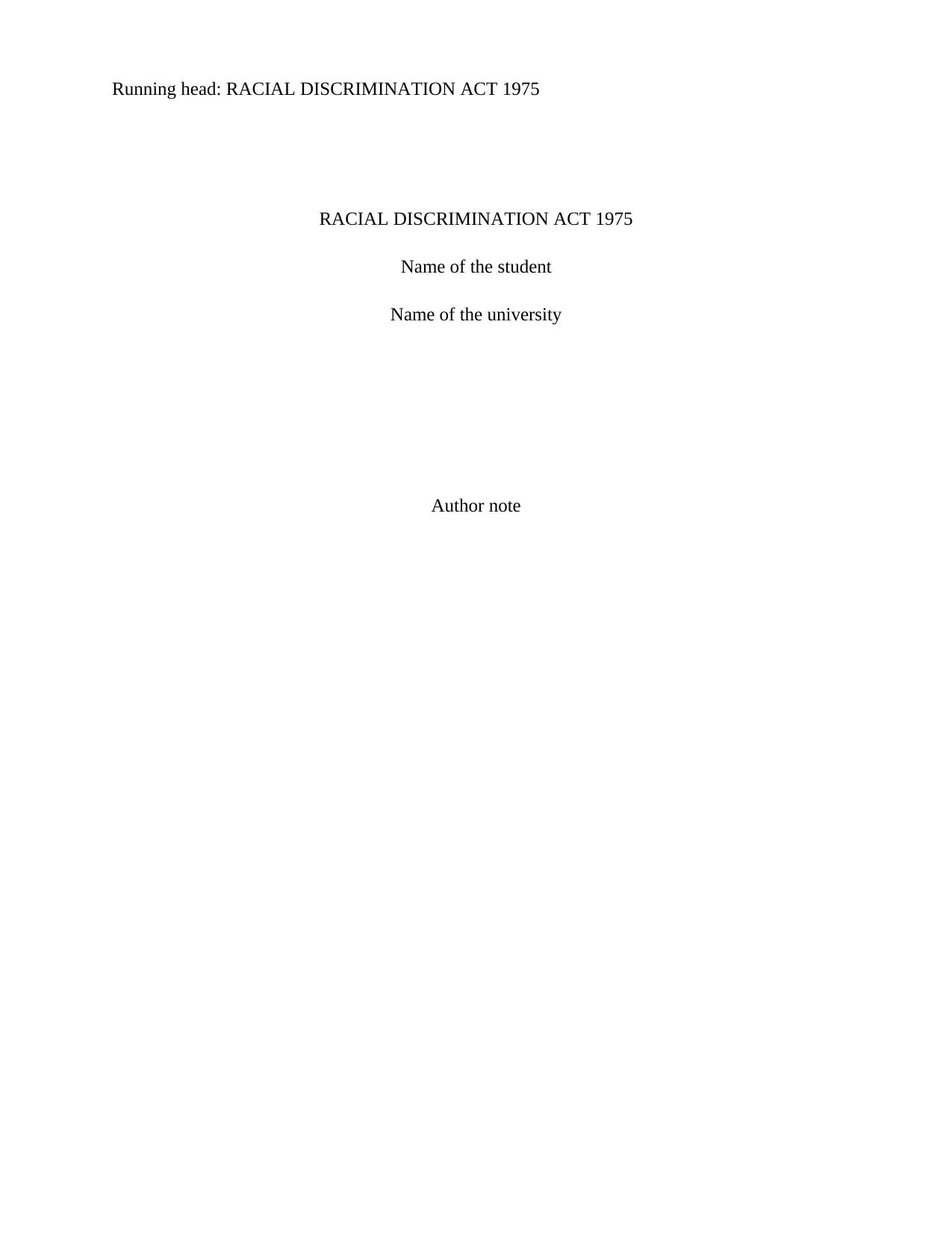
Running head: RACIAL DISCRIMINATION ACT 1975
RACIAL DISCRIMINATION ACT 1975
Name of the student
Name of the university
Author note
RACIAL DISCRIMINATION ACT 1975
Name of the student
Name of the university
Author note
Secure Best Marks with AI Grader
Need help grading? Try our AI Grader for instant feedback on your assignments.
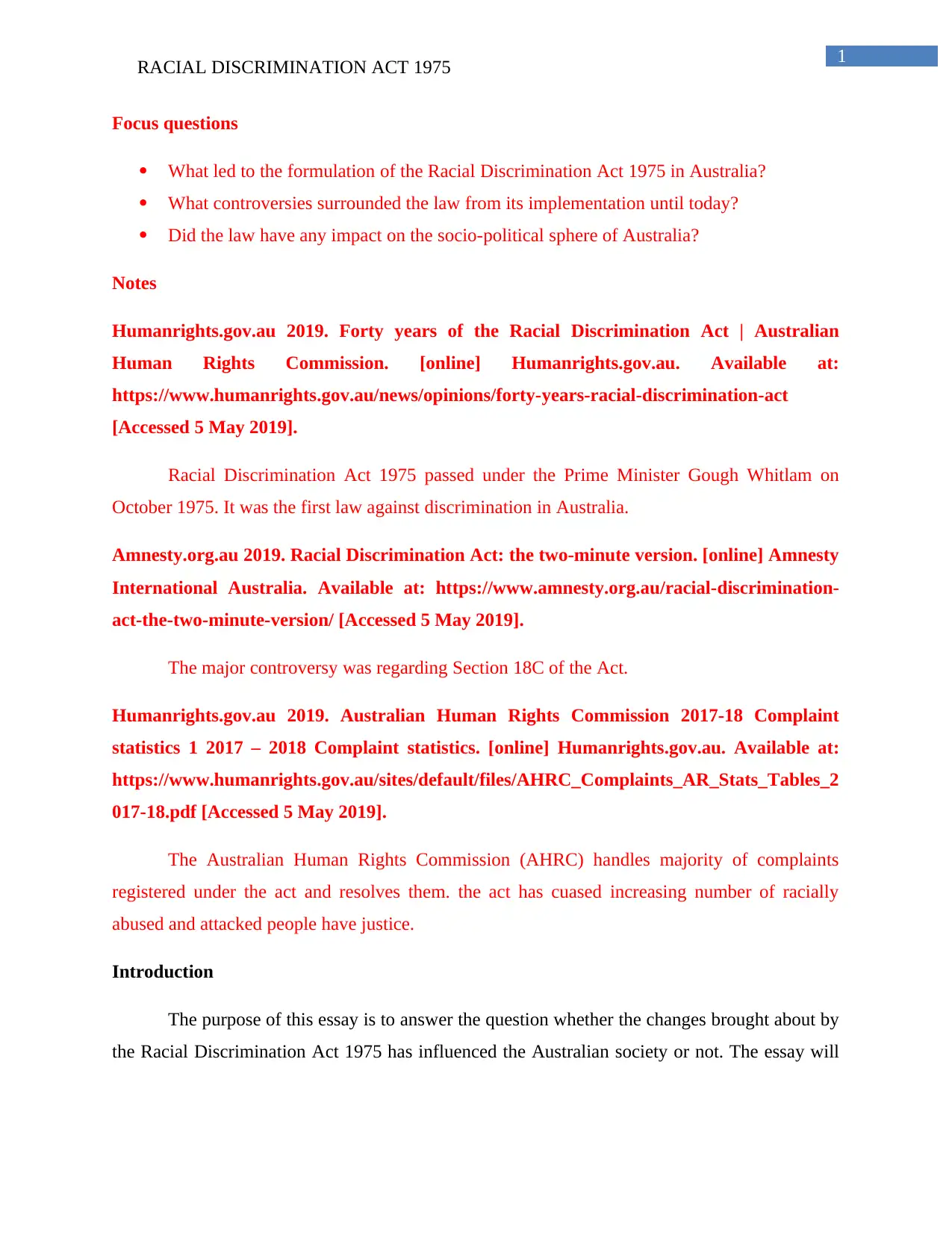
1
RACIAL DISCRIMINATION ACT 1975
Focus questions
What led to the formulation of the Racial Discrimination Act 1975 in Australia?
What controversies surrounded the law from its implementation until today?
Did the law have any impact on the socio-political sphere of Australia?
Notes
Humanrights.gov.au 2019. Forty years of the Racial Discrimination Act | Australian
Human Rights Commission. [online] Humanrights.gov.au. Available at:
https://www.humanrights.gov.au/news/opinions/forty-years-racial-discrimination-act
[Accessed 5 May 2019].
Racial Discrimination Act 1975 passed under the Prime Minister Gough Whitlam on
October 1975. It was the first law against discrimination in Australia.
Amnesty.org.au 2019. Racial Discrimination Act: the two-minute version. [online] Amnesty
International Australia. Available at: https://www.amnesty.org.au/racial-discrimination-
act-the-two-minute-version/ [Accessed 5 May 2019].
The major controversy was regarding Section 18C of the Act.
Humanrights.gov.au 2019. Australian Human Rights Commission 2017-18 Complaint
statistics 1 2017 – 2018 Complaint statistics. [online] Humanrights.gov.au. Available at:
https://www.humanrights.gov.au/sites/default/files/AHRC_Complaints_AR_Stats_Tables_2
017-18.pdf [Accessed 5 May 2019].
The Australian Human Rights Commission (AHRC) handles majority of complaints
registered under the act and resolves them. the act has cuased increasing number of racially
abused and attacked people have justice.
Introduction
The purpose of this essay is to answer the question whether the changes brought about by
the Racial Discrimination Act 1975 has influenced the Australian society or not. The essay will
RACIAL DISCRIMINATION ACT 1975
Focus questions
What led to the formulation of the Racial Discrimination Act 1975 in Australia?
What controversies surrounded the law from its implementation until today?
Did the law have any impact on the socio-political sphere of Australia?
Notes
Humanrights.gov.au 2019. Forty years of the Racial Discrimination Act | Australian
Human Rights Commission. [online] Humanrights.gov.au. Available at:
https://www.humanrights.gov.au/news/opinions/forty-years-racial-discrimination-act
[Accessed 5 May 2019].
Racial Discrimination Act 1975 passed under the Prime Minister Gough Whitlam on
October 1975. It was the first law against discrimination in Australia.
Amnesty.org.au 2019. Racial Discrimination Act: the two-minute version. [online] Amnesty
International Australia. Available at: https://www.amnesty.org.au/racial-discrimination-
act-the-two-minute-version/ [Accessed 5 May 2019].
The major controversy was regarding Section 18C of the Act.
Humanrights.gov.au 2019. Australian Human Rights Commission 2017-18 Complaint
statistics 1 2017 – 2018 Complaint statistics. [online] Humanrights.gov.au. Available at:
https://www.humanrights.gov.au/sites/default/files/AHRC_Complaints_AR_Stats_Tables_2
017-18.pdf [Accessed 5 May 2019].
The Australian Human Rights Commission (AHRC) handles majority of complaints
registered under the act and resolves them. the act has cuased increasing number of racially
abused and attacked people have justice.
Introduction
The purpose of this essay is to answer the question whether the changes brought about by
the Racial Discrimination Act 1975 has influenced the Australian society or not. The essay will
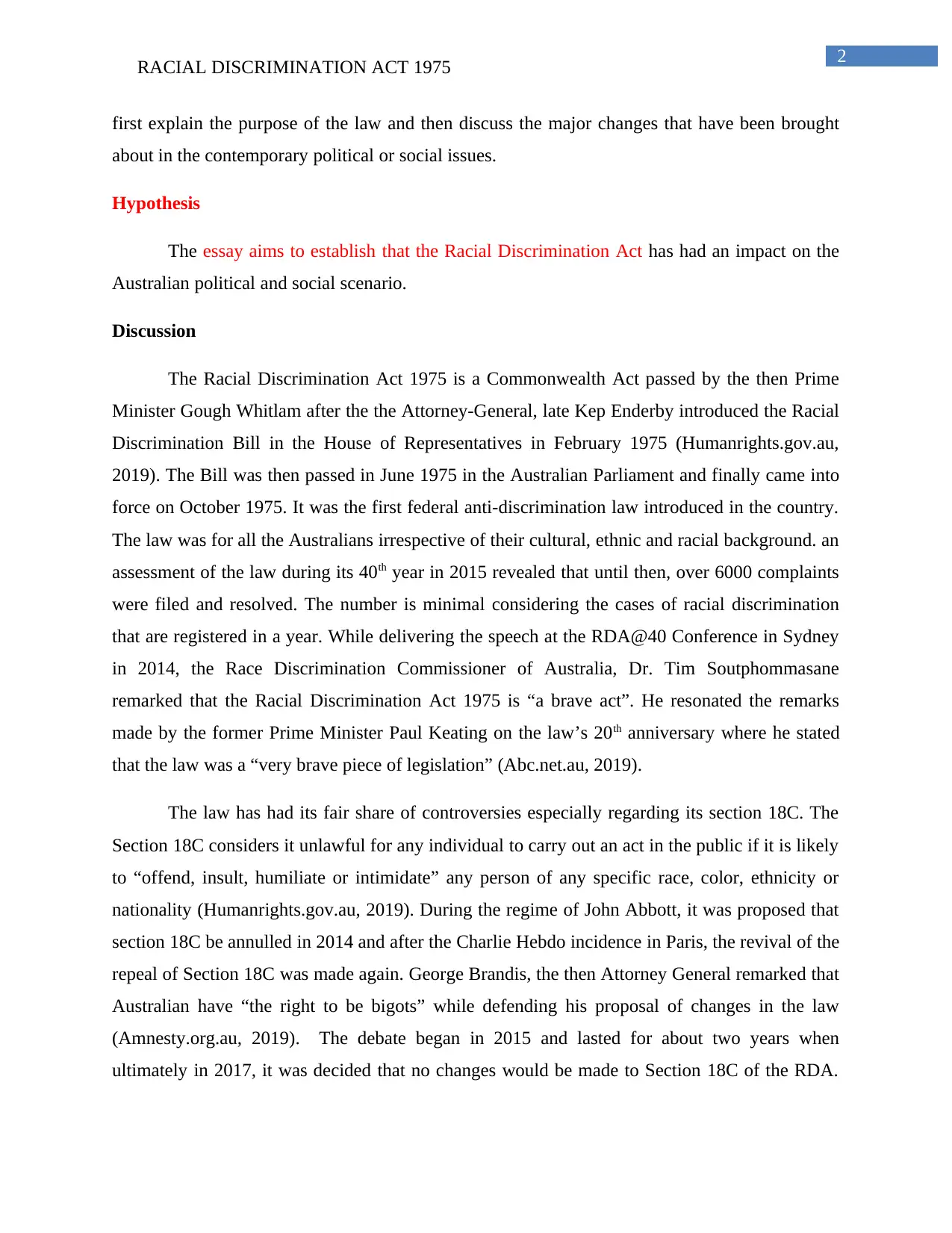
2
RACIAL DISCRIMINATION ACT 1975
first explain the purpose of the law and then discuss the major changes that have been brought
about in the contemporary political or social issues.
Hypothesis
The essay aims to establish that the Racial Discrimination Act has had an impact on the
Australian political and social scenario.
Discussion
The Racial Discrimination Act 1975 is a Commonwealth Act passed by the then Prime
Minister Gough Whitlam after the the Attorney-General, late Kep Enderby introduced the Racial
Discrimination Bill in the House of Representatives in February 1975 (Humanrights.gov.au,
2019). The Bill was then passed in June 1975 in the Australian Parliament and finally came into
force on October 1975. It was the first federal anti-discrimination law introduced in the country.
The law was for all the Australians irrespective of their cultural, ethnic and racial background. an
assessment of the law during its 40th year in 2015 revealed that until then, over 6000 complaints
were filed and resolved. The number is minimal considering the cases of racial discrimination
that are registered in a year. While delivering the speech at the RDA@40 Conference in Sydney
in 2014, the Race Discrimination Commissioner of Australia, Dr. Tim Soutphommasane
remarked that the Racial Discrimination Act 1975 is “a brave act”. He resonated the remarks
made by the former Prime Minister Paul Keating on the law’s 20th anniversary where he stated
that the law was a “very brave piece of legislation” (Abc.net.au, 2019).
The law has had its fair share of controversies especially regarding its section 18C. The
Section 18C considers it unlawful for any individual to carry out an act in the public if it is likely
to “offend, insult, humiliate or intimidate” any person of any specific race, color, ethnicity or
nationality (Humanrights.gov.au, 2019). During the regime of John Abbott, it was proposed that
section 18C be annulled in 2014 and after the Charlie Hebdo incidence in Paris, the revival of the
repeal of Section 18C was made again. George Brandis, the then Attorney General remarked that
Australian have “the right to be bigots” while defending his proposal of changes in the law
(Amnesty.org.au, 2019). The debate began in 2015 and lasted for about two years when
ultimately in 2017, it was decided that no changes would be made to Section 18C of the RDA.
RACIAL DISCRIMINATION ACT 1975
first explain the purpose of the law and then discuss the major changes that have been brought
about in the contemporary political or social issues.
Hypothesis
The essay aims to establish that the Racial Discrimination Act has had an impact on the
Australian political and social scenario.
Discussion
The Racial Discrimination Act 1975 is a Commonwealth Act passed by the then Prime
Minister Gough Whitlam after the the Attorney-General, late Kep Enderby introduced the Racial
Discrimination Bill in the House of Representatives in February 1975 (Humanrights.gov.au,
2019). The Bill was then passed in June 1975 in the Australian Parliament and finally came into
force on October 1975. It was the first federal anti-discrimination law introduced in the country.
The law was for all the Australians irrespective of their cultural, ethnic and racial background. an
assessment of the law during its 40th year in 2015 revealed that until then, over 6000 complaints
were filed and resolved. The number is minimal considering the cases of racial discrimination
that are registered in a year. While delivering the speech at the RDA@40 Conference in Sydney
in 2014, the Race Discrimination Commissioner of Australia, Dr. Tim Soutphommasane
remarked that the Racial Discrimination Act 1975 is “a brave act”. He resonated the remarks
made by the former Prime Minister Paul Keating on the law’s 20th anniversary where he stated
that the law was a “very brave piece of legislation” (Abc.net.au, 2019).
The law has had its fair share of controversies especially regarding its section 18C. The
Section 18C considers it unlawful for any individual to carry out an act in the public if it is likely
to “offend, insult, humiliate or intimidate” any person of any specific race, color, ethnicity or
nationality (Humanrights.gov.au, 2019). During the regime of John Abbott, it was proposed that
section 18C be annulled in 2014 and after the Charlie Hebdo incidence in Paris, the revival of the
repeal of Section 18C was made again. George Brandis, the then Attorney General remarked that
Australian have “the right to be bigots” while defending his proposal of changes in the law
(Amnesty.org.au, 2019). The debate began in 2015 and lasted for about two years when
ultimately in 2017, it was decided that no changes would be made to Section 18C of the RDA.
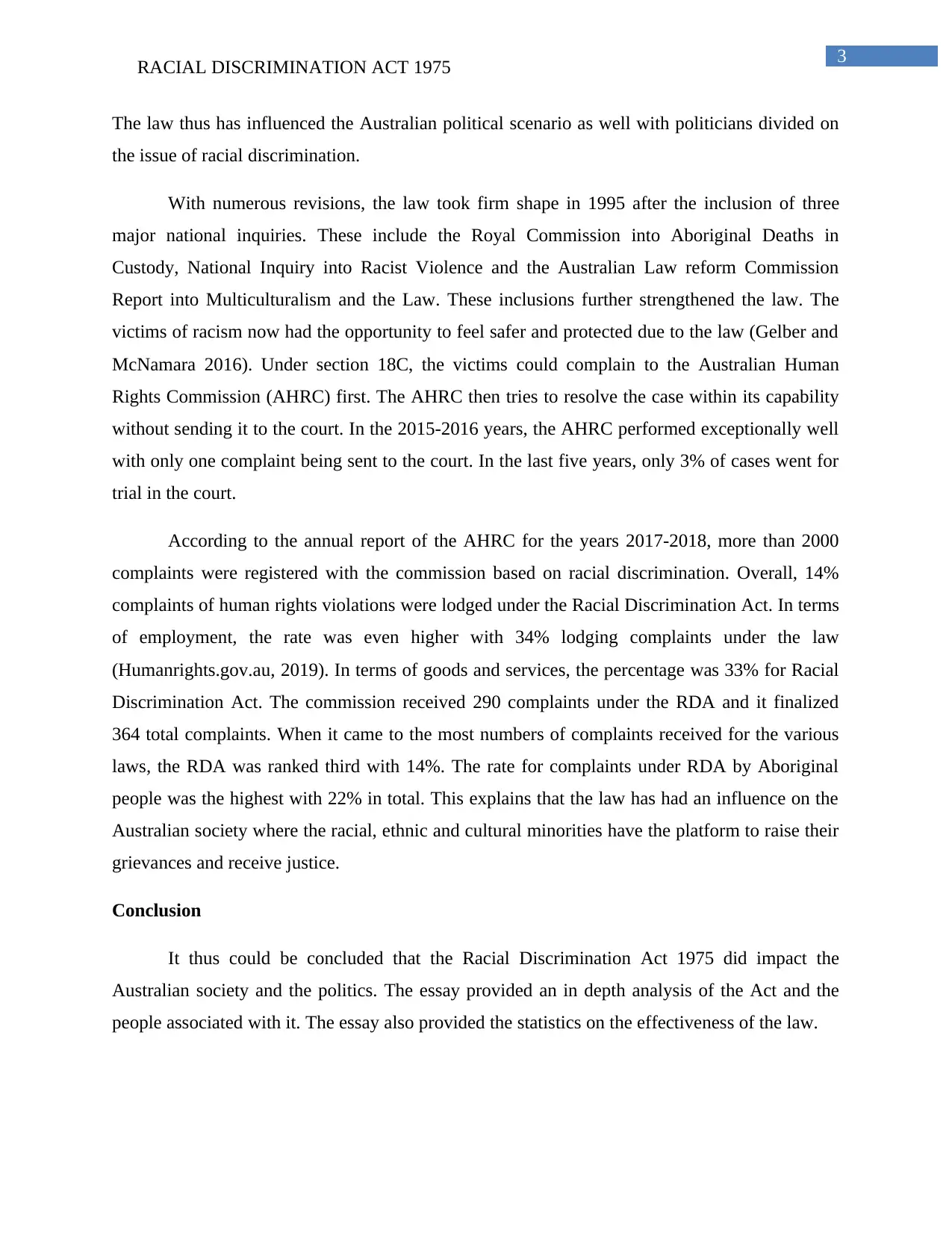
3
RACIAL DISCRIMINATION ACT 1975
The law thus has influenced the Australian political scenario as well with politicians divided on
the issue of racial discrimination.
With numerous revisions, the law took firm shape in 1995 after the inclusion of three
major national inquiries. These include the Royal Commission into Aboriginal Deaths in
Custody, National Inquiry into Racist Violence and the Australian Law reform Commission
Report into Multiculturalism and the Law. These inclusions further strengthened the law. The
victims of racism now had the opportunity to feel safer and protected due to the law (Gelber and
McNamara 2016). Under section 18C, the victims could complain to the Australian Human
Rights Commission (AHRC) first. The AHRC then tries to resolve the case within its capability
without sending it to the court. In the 2015-2016 years, the AHRC performed exceptionally well
with only one complaint being sent to the court. In the last five years, only 3% of cases went for
trial in the court.
According to the annual report of the AHRC for the years 2017-2018, more than 2000
complaints were registered with the commission based on racial discrimination. Overall, 14%
complaints of human rights violations were lodged under the Racial Discrimination Act. In terms
of employment, the rate was even higher with 34% lodging complaints under the law
(Humanrights.gov.au, 2019). In terms of goods and services, the percentage was 33% for Racial
Discrimination Act. The commission received 290 complaints under the RDA and it finalized
364 total complaints. When it came to the most numbers of complaints received for the various
laws, the RDA was ranked third with 14%. The rate for complaints under RDA by Aboriginal
people was the highest with 22% in total. This explains that the law has had an influence on the
Australian society where the racial, ethnic and cultural minorities have the platform to raise their
grievances and receive justice.
Conclusion
It thus could be concluded that the Racial Discrimination Act 1975 did impact the
Australian society and the politics. The essay provided an in depth analysis of the Act and the
people associated with it. The essay also provided the statistics on the effectiveness of the law.
RACIAL DISCRIMINATION ACT 1975
The law thus has influenced the Australian political scenario as well with politicians divided on
the issue of racial discrimination.
With numerous revisions, the law took firm shape in 1995 after the inclusion of three
major national inquiries. These include the Royal Commission into Aboriginal Deaths in
Custody, National Inquiry into Racist Violence and the Australian Law reform Commission
Report into Multiculturalism and the Law. These inclusions further strengthened the law. The
victims of racism now had the opportunity to feel safer and protected due to the law (Gelber and
McNamara 2016). Under section 18C, the victims could complain to the Australian Human
Rights Commission (AHRC) first. The AHRC then tries to resolve the case within its capability
without sending it to the court. In the 2015-2016 years, the AHRC performed exceptionally well
with only one complaint being sent to the court. In the last five years, only 3% of cases went for
trial in the court.
According to the annual report of the AHRC for the years 2017-2018, more than 2000
complaints were registered with the commission based on racial discrimination. Overall, 14%
complaints of human rights violations were lodged under the Racial Discrimination Act. In terms
of employment, the rate was even higher with 34% lodging complaints under the law
(Humanrights.gov.au, 2019). In terms of goods and services, the percentage was 33% for Racial
Discrimination Act. The commission received 290 complaints under the RDA and it finalized
364 total complaints. When it came to the most numbers of complaints received for the various
laws, the RDA was ranked third with 14%. The rate for complaints under RDA by Aboriginal
people was the highest with 22% in total. This explains that the law has had an influence on the
Australian society where the racial, ethnic and cultural minorities have the platform to raise their
grievances and receive justice.
Conclusion
It thus could be concluded that the Racial Discrimination Act 1975 did impact the
Australian society and the politics. The essay provided an in depth analysis of the Act and the
people associated with it. The essay also provided the statistics on the effectiveness of the law.
Secure Best Marks with AI Grader
Need help grading? Try our AI Grader for instant feedback on your assignments.

4
RACIAL DISCRIMINATION ACT 1975
RACIAL DISCRIMINATION ACT 1975
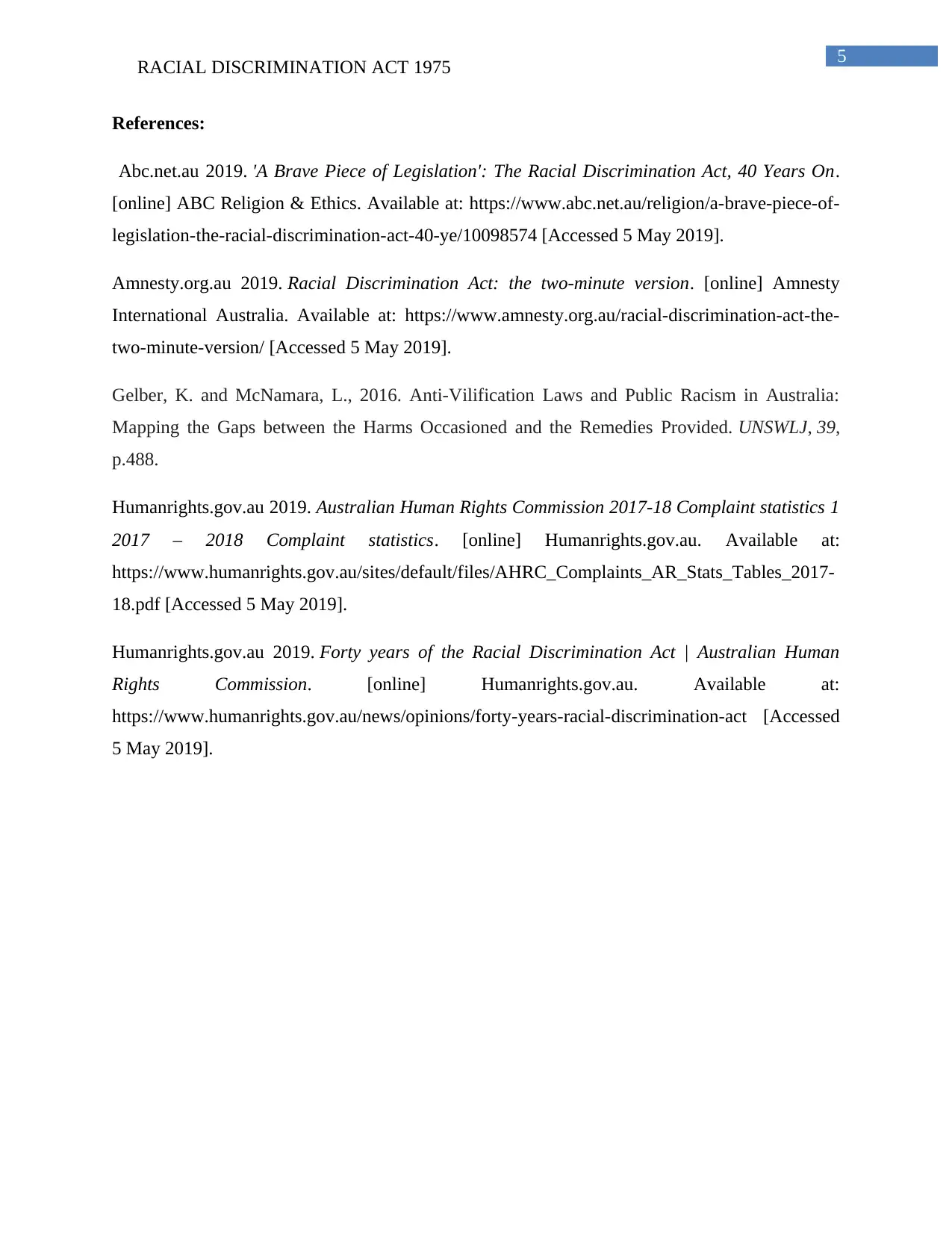
5
RACIAL DISCRIMINATION ACT 1975
References:
Abc.net.au 2019. 'A Brave Piece of Legislation': The Racial Discrimination Act, 40 Years On.
[online] ABC Religion & Ethics. Available at: https://www.abc.net.au/religion/a-brave-piece-of-
legislation-the-racial-discrimination-act-40-ye/10098574 [Accessed 5 May 2019].
Amnesty.org.au 2019. Racial Discrimination Act: the two-minute version. [online] Amnesty
International Australia. Available at: https://www.amnesty.org.au/racial-discrimination-act-the-
two-minute-version/ [Accessed 5 May 2019].
Gelber, K. and McNamara, L., 2016. Anti-Vilification Laws and Public Racism in Australia:
Mapping the Gaps between the Harms Occasioned and the Remedies Provided. UNSWLJ, 39,
p.488.
Humanrights.gov.au 2019. Australian Human Rights Commission 2017-18 Complaint statistics 1
2017 – 2018 Complaint statistics. [online] Humanrights.gov.au. Available at:
https://www.humanrights.gov.au/sites/default/files/AHRC_Complaints_AR_Stats_Tables_2017-
18.pdf [Accessed 5 May 2019].
Humanrights.gov.au 2019. Forty years of the Racial Discrimination Act | Australian Human
Rights Commission. [online] Humanrights.gov.au. Available at:
https://www.humanrights.gov.au/news/opinions/forty-years-racial-discrimination-act [Accessed
5 May 2019].
RACIAL DISCRIMINATION ACT 1975
References:
Abc.net.au 2019. 'A Brave Piece of Legislation': The Racial Discrimination Act, 40 Years On.
[online] ABC Religion & Ethics. Available at: https://www.abc.net.au/religion/a-brave-piece-of-
legislation-the-racial-discrimination-act-40-ye/10098574 [Accessed 5 May 2019].
Amnesty.org.au 2019. Racial Discrimination Act: the two-minute version. [online] Amnesty
International Australia. Available at: https://www.amnesty.org.au/racial-discrimination-act-the-
two-minute-version/ [Accessed 5 May 2019].
Gelber, K. and McNamara, L., 2016. Anti-Vilification Laws and Public Racism in Australia:
Mapping the Gaps between the Harms Occasioned and the Remedies Provided. UNSWLJ, 39,
p.488.
Humanrights.gov.au 2019. Australian Human Rights Commission 2017-18 Complaint statistics 1
2017 – 2018 Complaint statistics. [online] Humanrights.gov.au. Available at:
https://www.humanrights.gov.au/sites/default/files/AHRC_Complaints_AR_Stats_Tables_2017-
18.pdf [Accessed 5 May 2019].
Humanrights.gov.au 2019. Forty years of the Racial Discrimination Act | Australian Human
Rights Commission. [online] Humanrights.gov.au. Available at:
https://www.humanrights.gov.au/news/opinions/forty-years-racial-discrimination-act [Accessed
5 May 2019].
1 out of 6
Your All-in-One AI-Powered Toolkit for Academic Success.
+13062052269
info@desklib.com
Available 24*7 on WhatsApp / Email
![[object Object]](/_next/static/media/star-bottom.7253800d.svg)
Unlock your academic potential
© 2024 | Zucol Services PVT LTD | All rights reserved.

